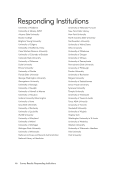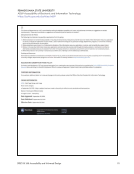38 Survey Results: Survey Questions and Responses It is part of our attempts to meet the research, teaching, and learning needs of our users. Look at VPATs. Process of purchasing new e-resources involves evaluation for accessibility by campus Information Communication Technology group. The Big Ten Academic Alliance will attempt to insert this language into consortial licenses and its member libraries may ask vendors to accept this language for their institutions’ individual agreements. The intent is to urge vendors to make improvements in their products to ensure that persons with disabilities can access their valuable material, not only to avoid risk, but also to promote access to information and education for all: Licensor shall comply with the Americans with Disabilities Act (ADA), by supporting assistive software or devices such as large print interfaces, text-to-speech output, voice-activated input, refreshable braille displays, and alternate keyboard or pointer interfaces, in a manner consistent with the Web Accessibility Initiative Web Content Accessibility Guidelines 2.0 AA (http://www.w3.org/WAI/guid-tech.html). Licensor shall ensure that product maintenance and upgrades are implemented in a manner that does not compromise product accessibility. Licensor shall provide to Licensee a current, accurate completed Voluntary Product Accessibility Template (VPAT) to demonstrate compliance with the federal Section 508 standards https://www.itic.org/policy/ accessibility). If the product does not comply, the Licensor shall adapt the Licensed Materials in a timely manner and at no cost to the Licensee in order to comply with applicable law. The library’s collection development manual doesn’t mention accessibility specifically, but we’re planning to add pertinent language. In practice, we consider the accessibility of materials (e.g., preferring captioned audiovisuals) in selection and acquisition activities. In our History of Medicine Division, accessibility is part of the acquisitions procedure. The division is committed to meeting requirements for section 508 for content in the digital collections. If items aren’t accessible, we make it accessible by captioning and transcribing them. The division offers audio description upon request. Finally, we provide contextual metadata for all content in NLM Digital Collections. To document the accessibility of electronic resources that the library licenses, and to hold vendors accountable for providing accessible electronic resources. We are currently revamping our formal collection development policies, and accessibility will be included among criteria. We are speaking with vendors about accessibility of their products, e.g., providing closed captioning (or allowing us to have it created). We attempt to insert this requirement into our license agreements with vendors whenever possible. We collaborate with provincial and national consortia in purchasing/licensing our e-resources. Accessibility is a pre-requisite for every license. We inquire and get the vendors official stance on accessibility and what they plan to do in the future to improve. We want to influence e-resource vendors and improve a11y! We also want ALL library users to access the information we pay lots of money for. Collection procedures will be emailed as a document, but we ask for a11y info (VPATs, WCAG 2.0 documentation), ask vendors for a11y staff/team contact info, ask to insert a11y license language, and sometimes do testing/report results back to vendors. Answered No N=14 I did not receive a timely staff response to this question. However, our university is currently evaluating our procurement processes campus-wide for accessibility, and I expect this initiative to impact acquisitions and collection development policies.




























































































































































